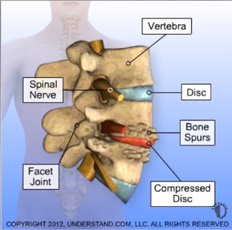Degenerative spinal disorders are a group of conditions that involve a loss of normal structure and function in the spine. These common disorders are associated with the normal effects of aging, but also may be caused by infection, tumors, muscle strains, or arthritis. Pressure on the spinal cord and nerve roots associated with spinal degeneration may be caused by disc displacement or herniation; spinal stenosis, a narrowing of the spinal canal; or osteoarthritis, cartilage breakdown at spinal joints.
The discs between the bones of the spine are made up of cartilage, fibrous tissue, and water. With age these discs can weaken and may flatten, bulge, break down, or herniate. Disc herniation, a common cause of pain associated spinal degeneration, occurs when the fibrous portion of a disc weakens and the disc nucleus pushes through and puts pressure on nearby nerves. In addition, a degenerating disc also may cause bony growths that can place additional pressure on the spinal cord.

Spinal stenosis, or narrowing of the spinal canal, is a condition potentially more serious than degenerative disc disease. As the spinal canal tightens, the spine and nerves may be significantly compressed and irritated, causing both back pain and pain that radiates to other parts of the body, depending on the location of the pressure on the nerves.
The primary symptoms of degenerative spinal disorders are sharp and/or chronic pain in the back and legs, weakness, limited motion, and sensory loss. If spinal degeneration leads to compression or injury of the spinal cord, weakness and limited motion may increase significantly. Loss of bladder and bowel function and problems with sexual function also may occur as the problem worsens. The specific symptoms often depend on the location of the structural problem in the spine.
Diagnosis often begins with a spinal x-ray, which does not show the discs but can show other bony changes in the spine. Magnetic resonance imaging (MRI) scans are the primary means of diagnosis because they can show the disc in detail and allow physicians to see the nerves and spinal canal space and how they are affected by the disease. Computed tomography (CT) scans also may be used. However, the diagnosis of back problems, even with MRI, can be difficult by the presence of findings that do not correlate well with a patient’s symptoms.

Dr. Ram R. Vasudevan, MD, FAANS
Austin NeuroSpine PLLC
5300 Bee Cave Road, Building 1,
Suite 220 Austin, TX 78746
Phone: (512) 640-0010
Monday: 8:00 AM – 5:00 PM
Tuesday: 8:00 AM – 5:00 PM
Wednesday: 8:00 AM – 5:00 PM
Thursday: 8:00 AM – 5:00 PM
Friday: 8:00 AM – 5:00 PM
Saturday: Closed
Sunday: Closed
© 2023 Austin NeuroSpine PLLC. All rights reserved.